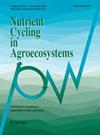Fertilization strategies to reduce yield-scaled N2O emissions based on the use of biochar and biochar-based fertilizers
IF 2.7
3区 农林科学
Q2 SOIL SCIENCE
引用次数: 0
Abstract
Abstract Novel fertilization strategies, such as the use of biochar-based fertilizers (BBFs) and the co-application of biochar with mineral fertilizers, have shown promising results for mitigating nitrous oxide (N 2 O) emissions and reducing N losses in agroecosystems. Two greenhouse experiments were performed with radish to evaluate: (1) the mitigation of yield-scaled N 2 O emissions using BBFs, produced at either 400 or 800 °C and enriched with urea, compared to the co-application of raw biochars with urea; and (2) the N 2 O mitigation potential of low rates of raw biochars, equivalent to those used with BBFs fertilization, co-applied with low and high N rates (90 and 180 kg N ha −1 ). BBF produced at 800 °C reduced yield-scaled N 2 O emissions by 32% as compared to the urea treatment, and by 60%, as compared to the combination of raw biochar with urea. This reduction was attributed to the slow rate of N release in BBF. On the contrary, the co-application of low rates of biochar with urea increased yield-scaled N 2 O emissions as compared to the fertilization with urea alone. Low rates of biochar (1.4–3.1 t ha −1 ) reduced yield-scaled N 2 O emissions only with a high rate of N fertilization. High-pyrolysis-temperature biochar, co-applied with synthetic fertilizer, or used to produce BBFs, demonstrated lower yield-scaled N 2 O emissions than biochar produced at a lower pyrolysis temperature. This study showed that BBFs are a promising fertilization strategy as compared to the co-application of biochar with synthetic fertilizers.基于使用生物炭和生物炭基肥料的减少产量比例的一氧化二氮排放的施肥策略
新型施肥策略,如使用生物炭基肥料(BBFs)和生物炭与矿物肥料共施,在减少农业生态系统中氧化亚氮(n2o)排放和减少氮损失方面显示出良好的效果。用萝卜进行了两项温室试验,以评估:(1)与原料生物炭与尿素共施相比,使用400°C或800°C生产并富集尿素的BBFs减轻了产量比例的一氧化氮排放;(2)与低氮和高氮(90和180 kg N ha - 1)共施的低剂量生生物炭,相当于与bbf施肥所使用的生物炭,减缓氮氧化物的潜力。与尿素处理相比,在800°C下生产的BBF减少了32%的氮排放量,与原料生物炭与尿素的组合相比,减少了60%。这种减少归因于BBF中N释放速度缓慢。相反,与单独施用尿素相比,低剂量生物炭与尿素联合施用增加了产量比例的氮氧化物排放。低剂量的生物炭(1.4-3.1 t hm - 1)只有在高施氮量的情况下才能降低按产量比例计算的氮氧化物排放。高热解温度的生物炭,与合成肥料共同施用,或用于生产bbf,显示出比在较低热解温度下生产的生物炭更低的产量比例的氮排放。本研究表明,与生物炭与合成肥料共施相比,bbf是一种很有前途的施肥策略。
本文章由计算机程序翻译,如有差异,请以英文原文为准。
求助全文
约1分钟内获得全文
求助全文
来源期刊

Nutrient Cycling in Agroecosystems
农林科学-土壤科学
CiteScore
5.90
自引率
3.20%
发文量
61
审稿时长
4.5 months
期刊介绍:
Nutrient Cycling in Agroecosystems considers manuscripts dealing with all aspects of carbon and nutrient cycling as well as management and examining their effect in ecological, agronomic, environmental and economic terms. Target agroecosystems include field crop, organic agriculture, urban or peri-urban agriculture, horticulture, bioenergy, agroforestry, livestock, pasture, and fallow systems as well as their system components such as plants and the fertility, chemistry, physics or faunal and micro-biology of soils. The scale of observation is the cycles in the soil-plant-animal system on or relevant to a field or watershed level as well as inputs from or losses to the anthroposphere, atmosphere and hydrosphere. Studies should thus consider the wider system in the examination of cycling and fluxes in agroecosystems or their components. These may include typically multi-year field observations, farm gate budgets, watershed studies, life cycle assessments, enterprise and economic analyses, or regional and global modeling. Management objectives may not only include the maximization of food, fiber and fuel production, but also its environmental and economic impact. The results must allow mechanistic conclusions of broad applicability and distinguish itself from empirical results or case studies of merely local or regional importance. If unsure whether a study fits into this scope, please contact the editor with a brief inquiry before manuscript submission.
 求助内容:
求助内容: 应助结果提醒方式:
应助结果提醒方式:


